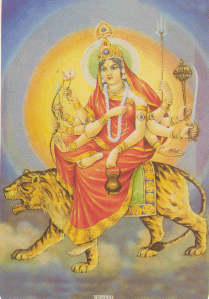Mahagauri
On the eighth day of Chaitra Navratri, Shakti is worshipped in the form of Mahagauri (Mahagauri=extremely white). She has four arms. In Her upper right hand She holds a trishul (trident) and in Her lower left hand She carries a Damaru (small, two-headed drum). Her upper left hand is in the Varada Mudra position, and Her lower right hand forms the Abhaya Mudra. She rides atop a white bull and rules the planetary body Rahu (In Vedic astrology, Rahu is the northern node of the Moon). The following origin of this form in mythology is related by Yogi Ananda Saraswathi:
She observed severe penance as Goddess Parvati to get earn Lord Siva as her husband. Once, Lord Shiva was rude to her by pointing out her dark complexion. She started observing hard penance. This went on for over a thousand years. During this period her body got covered with soil. It became darker than ever. Then one day when Lord Shiva came looking for Mother. He was pleased with her penance. Thereafter he took Maa to the Ganges and bathed her lovingly. Mother regained her beauty with pure complexion and earned the name Maha Gauri.
In this form Mahagauri represents purity and austerity. She scours and scrubs the filth from the souls of Her devotees and purifies their hearts. Both married and unmarried women especially worship Her on this day, as She is said to guide unmarried women in finding a good husband and She blesses married women with peaceful and harmonious marital lives.
Kumari Puja during Ashtami Puja celebrations also occurs on the eighth day of Chaitra Navratri, as related by this passage from astrosage.com:
On the sacred occasion of Ashtami Pooja, Kanya Poojan (feeding of little girls) are also done to please Goddesses of Navdurga (nine forms of Durga). Nine little girls are invited at home of worshippers and are fed varieties of delicious sweet dishes. Devotees pay the best homage to nine little girls considering them nine forms of Navdurga. This ritual accomplishes their Pooja and gives blessings of Nav Durga.
Her mantra is:
Shwete Vrishe Maha Rudha Shwetambardhara Shuchih
Maha Gauri Subham Dadhyanmahadev Pramodada
Which means in English:
Goddess Mahagauri who rides on white bull, wear pure white clothes, giver of happiness, be propitious to me.
For purposes of pronunciation, I have included a link to the spoken mantra (The mantra itself lasts for the first 35 seconds of this video, after which a speaker gives a lecture in Hindi).
Resources:
http://www.astrosage.com/festival/navratri/devi-maha-gauri.asp
http://vedicgoddess.weebly.com/3/post/2012/09/gauri-the-8th-aspect-of-durga-maa-navaratri.html




